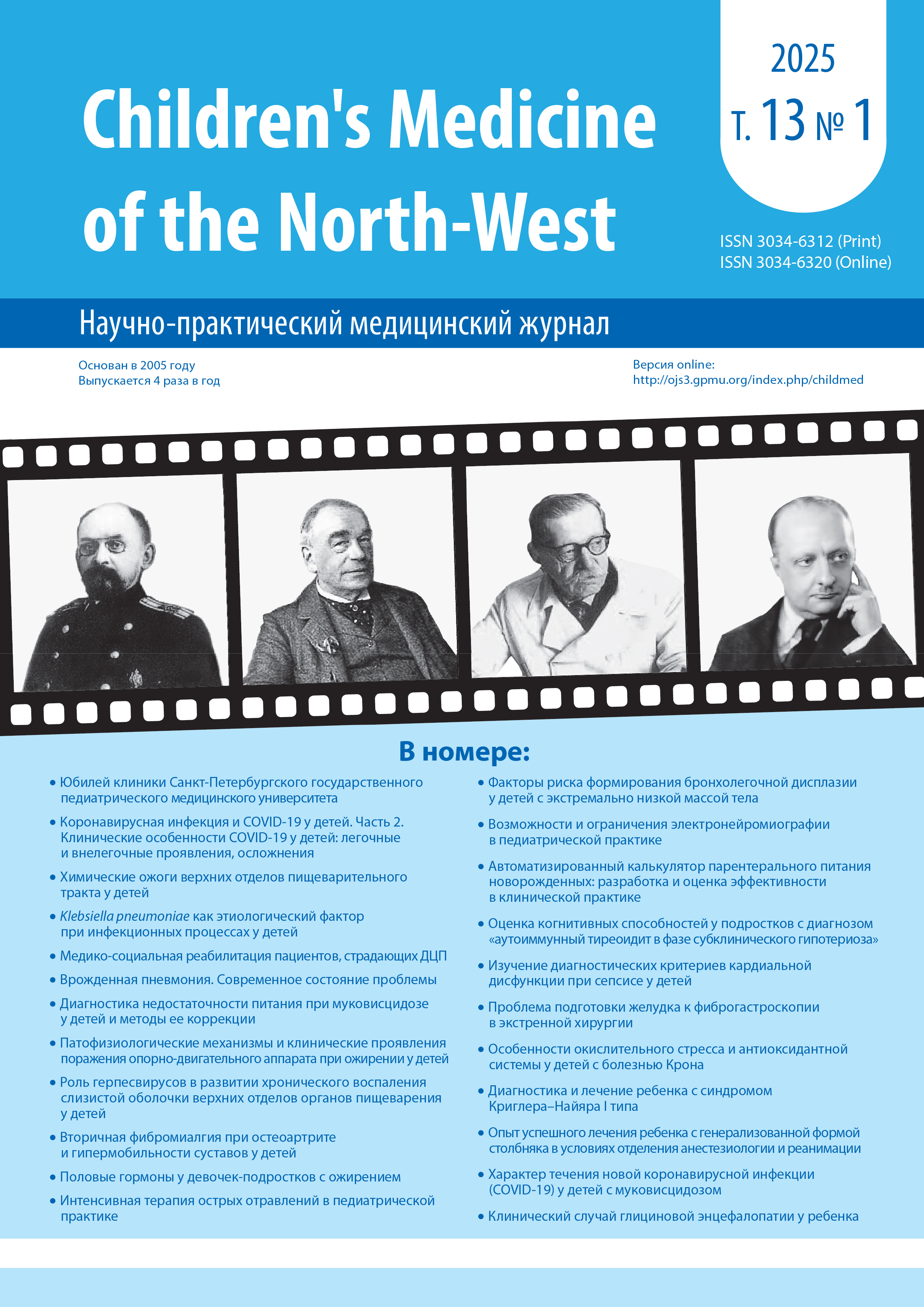ДИАГНОСТИКА И ЛЕЧЕНИЕ РЕБЕНКА С СИНДРОМОМ КРИГЛЕРА–НАЙЯРА I ТИПА
Abstract
Introduction. Crigler–Najjar syndrome is a malignant congenital hereditary unconjugated hyperbilirubinemia characterized by high mortality. Objective — to demonstrate a rare case of Crigler–Najjar syndrome type I in a 4-month-old patient, who was monitored for 3 years of life. Objectives — to review a clinical case with a follow-up study, to describe the features of diagnosis and treatment approaches, including liver transplantation. Material and methods. The article presents the data of clinical observation of a girl Yu. with Crigler–Najjar syndrome type I, who at the age of 4-5 months underwent examination and treatment in the gastroenterology department of the Morozov Children’s City Clinical Hospital, then was observed in other children’s medical institutions in Moscow during 2021–2024. Results. The obstetric history was burdened by toxicosis in the second and third trimesters. The child was born as a result of the second term physiological delivery. Due to persistent severe jaundice, the 4-month-old child was hospitalized. In dynamics, an increase in general cerebral and focal neurological symptoms was noted against the background of severe jaundice with an increase in bilirubin above 600 μmol/l. The patient was diagnosed with bilirubin encephalopathy, which required resuscitation. The identified deletions of exons 2-5, an increase in the number of “ta” repeats in the promoter region of the UGT1A gene encoding the enzyme uridine-5’-diphosphate glucuronosyltransferase, in a homozygous state confirmed the diagnosis: Krigler–Najjar syndrome type I. The child underwent orthotopic transplantation as the main treatment method, which ensured stabilization of the patient’s condition. Conclusion. The most important aspect of the treatment of Crigler-Najjar syndrome type I was maintaining the bilirubin level below toxic values, which allowed preparing the patient and performing orthotopic liver transplantation with a favorable outcome for life. The relatively unfavorable outcome of the disease is due to bilirubin encephalopathy that occurred before the liver transplantation and the development of structural epilepsy in the 3rd year of life due to late hospitalization.
References
Ильченко Л.Ю., Федоров И.Г., Тотолян Г.Г., Цветкова А.Г., Гавриленко Е.Г., Миронов К.О., Никитин И.Г. Наследственная неконъюгированная гипербилирубинемия (сочетание синдрома Криглер-Найяра II типа и синдрома Жильбера). Гепатология и гастроэнтерология. 2021;5(1):79–84.
Ткачук Е.А., Семинский И.Ж. Наследственные заболевания, протекающие с поражением печени (лекция). Байкальский медицинский журнал. 2024;3(1):78–95. DOI: 10.57256/2949-0715-2024-3-1-78-95.
American Liver foundation. Crigler-Najjar syndrome. Доступно по: https://liverfoundation.org/liver-diseases/pediatric-liver-information-center/pediatric-liver-disease/crigler-najjar-syndrome/ (дата обращения: 25.12.2024).
Sun L., Li M., Zhang L., Teng X., Chen X. et al. Differences in UGT1A1 gene mutations and pathological liver changes between Chinese patients with Gilbert syndrome and Crigler- Najjar syndrome type II. Medicine (Baltimore). 2017;96(45):e8620. DOI: 10.1097/MD.0000000000008620.
D’Antiga L., Beuers U., Ronzitti G., Brunetti-Pierri N. et.al. Gene Therapy in Patients with the Crigler-Najjar Syndrome. N Engl J. 2023;389(7):620–631. DOI: 10.1056/NEJMoa2214084.
Schröder H., Junge N., Herden U., Deutschmann А., Weidemann A.S., Schmitt D.K., Grabhorn E.F. Outcome of liver transplantation and prevalence of liver fibrosis in Crigler-Najjar syndrome. Clin Transplant. 2021;35(4):e14219. DOI: 10.1111/ctr.14219.
Tcaciuc E., Podurean M., Tcaciuc A. Management of Crigler-Najjar syndrome. Med Pharm Rep. 2021;8(1):64–67. DOI: 10.15386/mpr-2234.
Cozzi L., Nuti F., Degrassi I., Civeriati D., Paolella G. Gabriella Nebbia Gilbert or Crigler–Najjar syndrome? Neonatal severe unconjugated hyperbilirubinemia with P364L UGT1A1 homozygosity. Italian Journal of Pediatrics. 2022;48(1):59. doi: 10.1186/s13052-022-01251-4.
Strauss K.A., Ahlfors C.E., Soltys K. et al. Crigler-Najjar syndrome type 1: pathophysiology, natural history, and therapeutic frontier. Hepatology. 2020;71:1923–1939. DOI: 10.1002/hep.30959.
Bhandari J., Thada P.K., Shah M., Yadav D. Crigler-Najjar Syndrome. In: StatPearls [Internet]. Treasure Island (FL): StatPearls Publishing; 2024 Jan. PMID: 32965842 Bookshelf ID: NBK562171.
Кильдиярова Р.Р., Лобанов Ю.Ф. Наглядная детская гастроэнтерология и гепатология: учебное пособие. Москва: ГЭОТАР-Медиа, 2024: 118.



